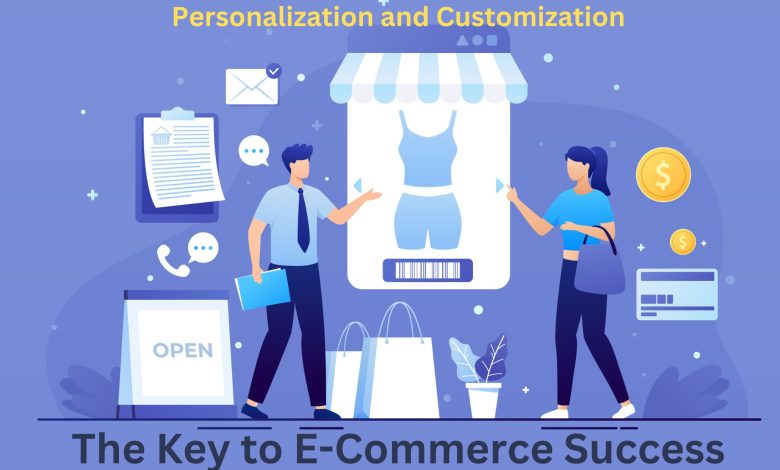Personalization and Customization: The Key to E-Commerce Success
Personalization and Customization

In the ever-evolving landscape of e-commerce, personalization and customization have emerged as key factors for driving success. With consumers seeking unique and tailored experiences, incorporating personalization and customization into the e-commerce website development process has become essential.
By leveraging data and advanced technologies, businesses can deliver targeted product recommendations, tailor offers, customize the user experience, and personalize content. This blog explores the significance of personalization and customization in e-commerce, highlighting their ability to enhance customer engagement, increase conversions, and foster long-term customer loyalty.
Discover how integrating these strategies into the website development process can empower businesses to thrive in the competitive world of e-commerce.
Understanding Personalization and Customization in E-Commerce
Managing an e-commerce website involves more than just listing products and processing orders. To truly succeed in today’s competitive online market, businesses must prioritize personalization and customization. These two concepts play a vital role in enhancing the user experience, increasing customer engagement, and driving conversions.
1. Personalization
Personalization refers to tailoring the shopping experience to the preferences, interests, and behavior of individual customers.
It involves leveraging customer data to deliver targeted content, recommendations, and offers. By understanding customers’ needs and preferences, e-commerce websites can provide a more relevant and personalized experience, leading to higher customer satisfaction and loyalty.
2. Custoimzation
Customization, on the other hand, allows customers to personalize the products or services they purchase. It empowers customers to choose specific features, designs, or configurations that align with their preferences. Offering customization options not only caters to customers’ individual tastes but also creates a sense of ownership and uniqueness.
Managing an e-commerce website involves implementing effective personalization and customization strategies. This includes collecting and analyzing customer data, utilizing machine learning algorithms to generate personalized recommendations, creating intuitive customization interfaces, and ensuring seamless integration of these features into the website’s user interface.
By incorporating personalization and customization into their e-commerce websites, businesses can create differentiated and memorable experiences for their customers.
The Power of Personalized Product Recommendations
Personalized product recommendations have become a cornerstone of successful e-commerce websites. By leveraging customer data and advanced algorithms, personalized recommendations have the power to enhance the user experience, increase engagement, and drive conversions.
These recommendations are tailored to each individual customer based on their browsing history, purchase behavior, preferences, and demographic information. By analyzing this data, e-commerce websites can provide relevant and targeted suggestions, guiding customers towards products they are most likely to be interested in.
The effectiveness of personalized product recommendations lies in their ability to save customers time, improve discoverability, and create a more personalized shopping journey. Customers are more likely to make a purchase when they are presented with products that align with their tastes and needs.
Furthermore, personalized recommendations can also increase cross-selling and upselling opportunities, leading to higher average order values.
Successful e-commerce websites have seen significant improvements in key metrics such as conversion rates, average order value, and customer retention by implementing personalized product recommendations.
By harnessing the power of data-driven personalization, e-commerce businesses can provide a highly tailored and relevant shopping experience, fostering customer loyalty and driving overall success.
Tailoring Offers and Discounts to Individual Customers
In the fiercely competitive world of e-commerce, one-size-fits-all offers and discounts are no longer enough to capture the attention and loyalty of customers. Personalizing offers and discounts to cater to individual customers has become a crucial strategy for e-commerce success.
By collecting and analyzing customer data, e-commerce websites can gain valuable insights into individual preferences, purchase history, and browsing behavior. This data can then be utilized to create targeted and personalized offers that resonate with customers on a deeper level.
Segmenting customers based on demographics, purchase patterns, or engagement levels allows e-commerce businesses to tailor their promotions to specific groups.
Whether it’s sending exclusive discounts via email, offering personalized recommendations based on past purchases, or providing targeted upsell and cross-sell opportunities, personalized offers have a higher likelihood of converting customers and driving repeat purchases.
Moreover, by leveraging automation and artificial intelligence, e-commerce websites can dynamically adjust prices and promotions in real-time, responding to individual customer behaviors and maximizing the impact of personalized offers.
By personalizing offers and discounts, e-commerce businesses can create a sense of exclusivity and relevance, fostering stronger customer relationships and ultimately boosting sales and customer loyalty.
Customizing the User Experience
In the fiercely competitive world of e-commerce, delivering a personalized user experience has become imperative for success.
Customization allows e-commerce websites to tailor their offerings to individual customers, enhancing engagement, satisfaction, and ultimately driving conversions. Here are some key aspects to consider when customizing the user experience:
- Firstly, creating personalized landing pages and homepages can make a significant impact. By analyzing customer data and preferences, e-commerce websites can present relevant products, offers, and content as soon as users land on their site.
- Secondly, implementing customization options for products and services empowers customers to tailor their purchases to their liking. From choosing color variations to adding personalized engravings, allowing customers to customize their purchases fosters a sense of ownership and connection with the brand.
Successful e-commerce websites have leveraged user experience customization to great effect. By providing intuitive customization interfaces and seamless user flows, these websites create a delightful and personalized shopping journey.
When incorporating user experience customization into e-commerce website development, it’s essential to strike a balance between simplicity and flexibility. Clear navigation, user-friendly interfaces, and intuitive customization tools ensure a smooth and enjoyable experience for users, regardless of their technical expertise.
By customizing the user experience, e-commerce websites can forge stronger connections with their customers, leading to increased loyalty and higher conversion rates.
Personalizing Content and Recommendations
In today’s competitive e-commerce landscape, personalizing content and recommendations is crucial for engaging customers and driving conversions. By tailoring the content to individual preferences and behavior, e-commerce websites can create a personalized experience that resonates with customers on a deeper level.
To personalize content effectively, businesses can utilize strategies such as analyzing customer data, including browsing history, purchase patterns, and demographic information. By leveraging AI and machine learning algorithms, e-commerce websites can generate personalized product recommendations, relevant blog articles, and targeted email campaigns.
The implementation of content personalization can take various forms, including dynamic product banners, personalized landing pages, and tailored blog content based on user interests. These efforts create a unique and customized experience for each customer, increasing engagement and encouraging repeat visits.
Successful e-commerce websites have demonstrated the power of content personalization. Amazon, for example, showcases personalized product recommendations on their homepage, while Netflix suggests relevant movies and TV shows based on individual viewing history.
These examples highlight the effectiveness of content personalization in enhancing the user experience and driving conversions.
Implementing content personalization requires careful consideration of customer preferences, data privacy, and compliance with regulations. By balancing personalization with respect for user privacy, businesses can create a win-win situation that benefits both the customer and the e-commerce brand.
Overcoming Challenges and Ensuring Privacy
Addressing privacy concerns in personalization and customization is crucial to building trust with customers.
- Implementing transparent data collection practices and obtaining explicit consent for data usage are essential steps.
- Businesses must prioritize data security and invest in robust encryption and storage methods to safeguard customer information.
- Striking the right balance between personalization and privacy requires adopting anonymization techniques and minimizing data retention.
- Compliance with data protection regulations, such as GDPR and CCPA, is paramount.
- Regular audits and assessments should be conducted to ensure ongoing compliance and adherence to evolving privacy standards.
- Educating customers about privacy measures and allowing them control over their data empowers them and strengthens their trust in the e-commerce website.
Measuring the Impact of Personalization and Customization
To determine the effectiveness of personalization and customization efforts in e-commerce, measuring key metrics is essential. Here are some important tips for measuring the impact:
A. Key metrics
Track important metrics such as conversion rates, average order value, customer retention rates, and revenue generated. Compare these metrics between personalized and non-personalized segments to gauge the impact of personalization.
B. A/B testing
Conduct experiments by splitting users into groups, with one group experiencing personalized content or recommendations while the other group receives non-personalized experiences. Measure the performance of each group to identify the uplift in metrics resulting from personalization.
C. Customer feedback and behavior
Analyze qualitative feedback from customers regarding their personalized experiences. Additionally, examine customer behavior metrics like click-through rates, time spent on site, and engagement with personalized elements to assess the impact on user engagement and satisfaction.
D. Tools and technologies
Utilize analytics platforms and customer relationship management (CRM) systems to collect and analyze data. Leverage data visualization tools and reporting features to monitor the impact of personalization initiatives over time.
By consistently measuring these metrics, e-commerce businesses can evaluate the effectiveness of their personalization and customization strategies, make data-driven decisions, and refine their approaches to optimize user experiences and drive business growth.
Wrapping Up
In conclusion, personalization and customization are vital ingredients for achieving e-commerce success. By tailoring the shopping experience to individual customers, businesses can enhance engagement, drive conversions, and foster long-term loyalty.
Personalized product recommendations, targeted offers, and customized user experiences create a sense of relevance and cater to unique preferences. However, it is crucial to balance personalization with respect for user privacy and comply with data protection regulations.
By measuring the impact of personalization efforts and continuously optimizing strategies, e-commerce websites can stay ahead of the competition. Embracing personalization and customization is not just a trend but a key driver for future e-commerce growth and customer satisfaction.



